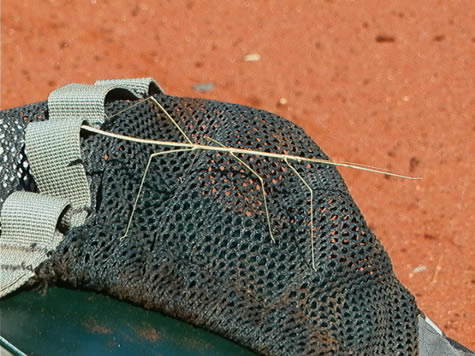2001 August 27, Monday. West of Atula Station.
The stick insect we were lucky enough to see today was the most incredible example of camouflage which many of us had ever seen. Jason was about to brush a stem of spinifex grass off his Camelbak, when it shied away from his hand, and crouched again to sit perfectly still just centimetres away, looking just as much like the surrounding grassland as it had done before.

A close inspection revealed the simple form – four legs and a long body like a slender piece of straw. After staring in amazement for some minutes, we looked at the landscape around us, imagining the thousands of creatures which could be right in front of us, though blended with their surroundings so perfectly as to be completely hidden from our view. As we were attempting to discover which end was the front, he revealed another pair of legs, (for a total of six) which we had not been able to see earlier despite the thorough scrutiny he had undergone.
Because of the extreme scarcity of food in arid regions, predators do not give their prey second chances, and the best defence for palatable creatures such as our remarkable little friend, is to not be seen by them in the first instance – by camouflage.
We have seen a wonderful example of this in the serrated skin of the lizards which populate the desert. A central bearded dragon sitting on a rough textured log, as long as he keeps still, is safe from the kites and other birds of prey which might make a meal of him. Likewise, a burrowing skink could easily pass for a eucalypt twig, lying motionless in the sand collecting energy from the sun.
A large portion of desert life lies dormant for most of the year (and often for several years) until times of rain animate the countryside. Those animals which lie incompletely concealed under the earth, need camouflage to remain undetected while they are in the dormant state. Some species of frogs demonstrate this well by matching the their skin to the colour and pattern of the soil in which they live.
What animals can you think of which hide using camouflage? How many can you think of in the country in which you live? What techniques do other animals use to protect themselves from predators, if they do not blend well with their surroundings? How could you find an animal which is hiding using camouflage?
bel